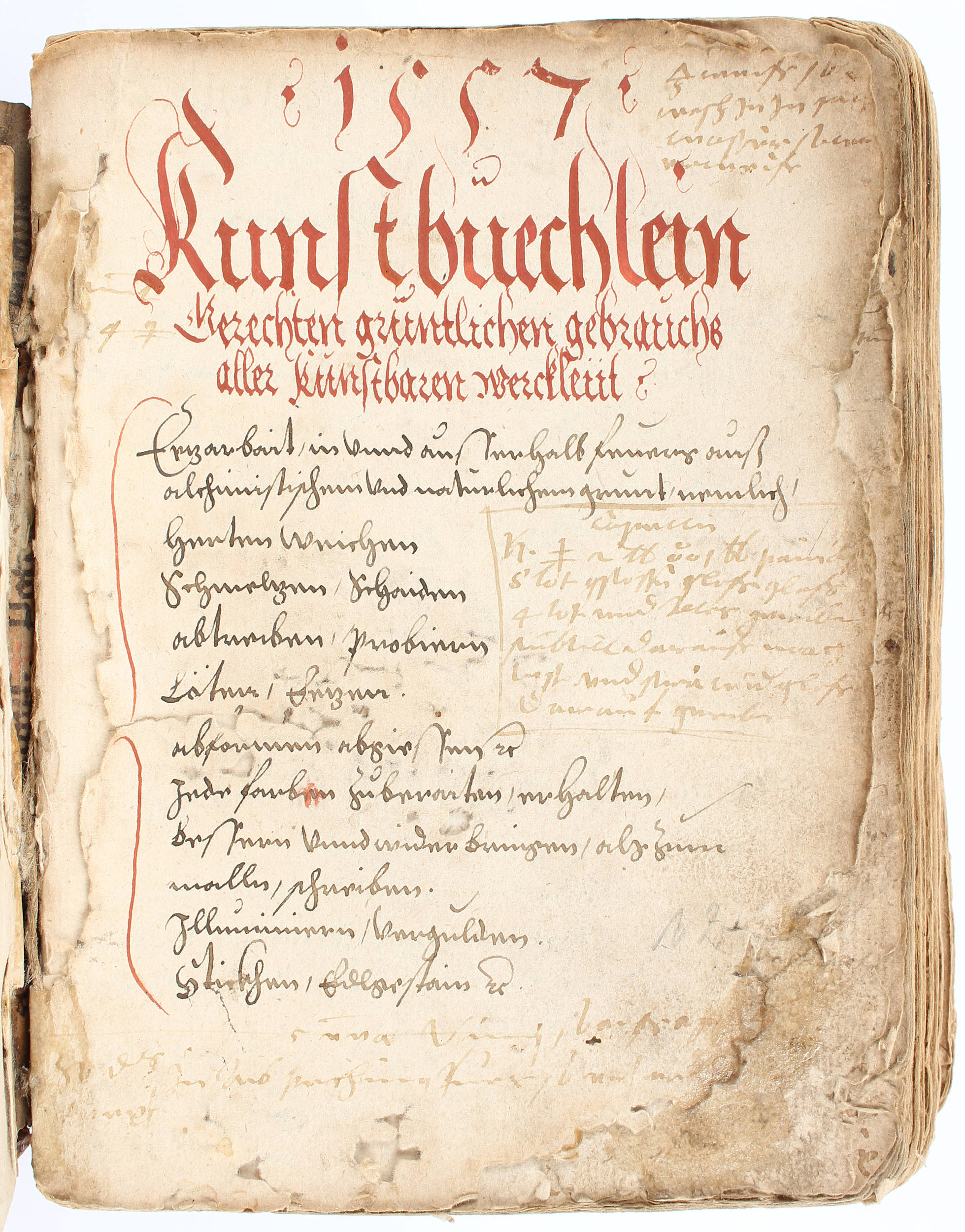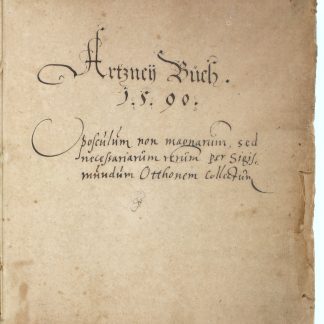[SOLD]
This item has sold. We are always interested in acquiring another copy or any item of comparable quality.
A practical collection of instructions for dyeing, gilding, soldering, and pigment preparation
Kunstbüechlein Gerechten grüntlichen gebrauchs aller kunstbaren Werckleut.
4to (155 x 205 mm). German ms. on paper: German cursive in red and brown ink by two scribes. (4) ff., 1 bl. f., 87 (instead of 92) numbered ff. (wanting ff. 2, 7, 37-40), (38) ff. (probably wanting 10 ff.). Altogether 130 (instead of 148?) ff. Contemporary blind-stamped calf.
A small artisanal workshop's handwritten practical collection of instructions for dyeing, gilding, soldering, and pigment preparation: partly a contemporary manuscript copy of the book known as the "Kunstbüchlein", first published in 1531 as "Rechter Gebrauch der Alchimie", but here significantly expanded by two contemporary scribes. Formerly attributed to Georg Agricola, the printed manual was quickly reissued under the title used here and became a standard work, the "predecessor to many successors" (cf. Brüning). "The contents are purely practical and consist of chemical receipts for everyday wants and have nothing to do with alchemy strictly so called. In fact the title affords an early use of the word alchemical in the later wider sense of chemical. The substances employed are common and the operations are such as would be familiar to various classes of artists and workmen" (Ferguson). "These little technical manuals were first intended for miners and metallurgists, mint officicals, goldsmiths, and craftsmen. The 'Probierbüchlein' and 'Kunstbüchlein' in particular, with their recipes for assaying, chemical tests, the preparation of alloys and of dyes, were important for the artisanal trade, as they were for book art" (cf. Darmstädter 12). While the published "Kunstbüchlein" were generally printers' compilations "compiled from [...] workshop notes, from word-of-mouth sources, and from various 'experimental' treatises" (Eamon, p. 113f.), the present manuscript demonstrates that the exchange of such technical knowledge in fact flowed both ways: the craft secrets first drawn from artisans' experience and disseminated by printers are here re-absorbed into a new artisanal how-to manuscript; the wheel has come full circle.
Indeed, the present manuscript goes considerably beyond the known printed versions, discussing further artisanal techniques such as the preparation and application of pigments, dyeing and colouring precious metals, soldering, working with sulphur, oleum etc. On the verso of the title-page, we find a list of "characters and names of the various metals" with their symbols as well as "several alchemical terms Latinized", quite as in the published book. But even here several pages of entirely new material are intercalated: written in a rather cursory hand, they mainly treat fixing processes for powdered metals. This section is followed by dyeing techniques for cloth, feathers, and parchment, methods for producing gold paint and ink, for gilding glass, for preparing and properly tempering a scumble, for producing brown, purple, blue, green and other pigments; much material on gilding and silver-plating copper jewellry; for mixing salt of borax for use as a soldering flux; also, discussions of more immediately chemical processes such as purging sulphur or sublimating mercury. The classic scope of the printed "Kunstbüchlein" is covered by the first 58 numbered leaves of this manuscript; they are followed by more than 140 pages of additional recipes and techniques. While these, too, are clearly in the style of the contemporary "Probierbücher", they are not attributable to any distinct published source and are apparently drawn mainly from professional experience. These parts discuss the removal of "Spiessglas" (antimony), assaying ore for metals contained, and various stove-building techniques ("Saigerofn", "Terrofn", "Pachofn").
Variously fingerstained; some dampstains and corner and edge defects with some text loss to first and last leaves. Binding rubbed and bumped with traces of worming; spine-ends defective. Curiously, a large central section of the blind-stamped lower cover has been cut out, possibly removing a supralibros.
A fine survival of a manuscript artisanal handbook clearly once in actual use by Renaissance practitioners.
Cf. VD 16, R 492; IA 101.543; Brüning I, 169 (1531 Cologne ed.); R 493 (1535 Augsburg ed.; R 495; Hohenemser 1301 (1537 ed.); Darmstädter 82 (1549 ed.). Ferguson II, 246. William Eamon, Science and the Secrets of Nature: Books of Secrets in Medieval and Early Modern Culture (Princeton UP, 1994), pp. 112ff.











